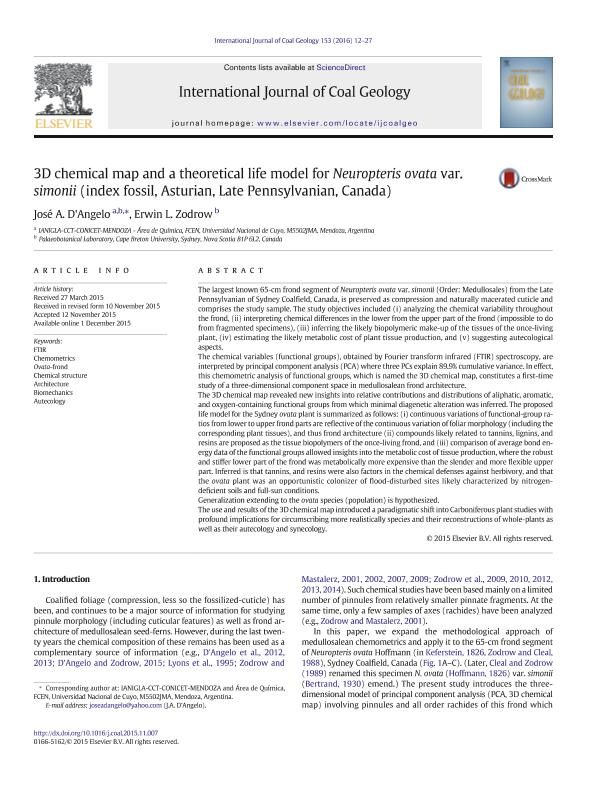Artículo
3D chemical map and a theoretical life model for Neuropteris ovata var. simonii (index fossil, Asturian, Late Pennsylvanian, Canada)
Fecha de publicación:
01/2016
Editorial:
Elsevier Science
Revista:
International Journal Of Coal Geology
ISSN:
0166-5162
Idioma:
Inglés
Tipo de recurso:
Artículo publicado
Clasificación temática:
Resumen
The largest known 65-cm frond segment of Neuropteris ovata var. simonii (Order: Medullosales) from the Late Pennsylvanian of Sydney Coalfield, Canada, is preserved as compression and naturally macerated cuticle and comprises the study sample. The study objectives included (i) analyzing the chemical variability throughout the frond, (ii) interpreting chemical differences in the lower from the upper part of the frond (impossible to do from fragmented specimens), (iii) inferring the likely biopolymeric make-up of the tissues of the once-living plant, (iv) estimating the likely metabolic cost of plant tissue production, and (v) suggesting autecological aspects. The chemical variables (functional groups), obtained by Fourier transform infrared (FTIR) spectroscopy, are interpreted by principal component analysis (PCA) where three PCs explain 89.9% cumulative variance. In effect, this chemometric analysis of functional groups, which is named the 3D chemical map, constitutes a first-time study of a three-dimensional component space in medullosalean frond architecture. The 3D chemical map revealed new insights into relative contributions and distributions of aliphatic, aromatic, and oxygen-containing functional groups from which minimal diagenetic alteration was inferred. The proposed life model for the Sydney ovata plant is summarized as follows: (i) continuous variations of functional-group ratios from lower to upper frond parts are reflective of the continuous variation of foliar morphology (including the corresponding plant tissues), and thus frond architecture (ii) compounds likely related to tannins, lignins, and resins are proposed as the tissue biopolymers of the once-living frond, and (iii) comparison of average bond energy data of the functional groups allowed insights into the metabolic cost of tissue production, where the robust and stiffer lower part of the frond was metabolically more expensive than the slender and more flexible upper part. Inferred is that tannins, and resins were also factors in the chemical defenses against herbivory, and that the ovata plant was an opportunistic colonizer of flood-disturbed sites likely characterized by nitrogen-deficient soils and full-sun conditions. Generalization extending to the ovata species (population) is hypothesized. The use and results of the 3D chemical map introduced a paradigmatic shift into Carboniferous plant studies with profound implications for circumscribing more realistically species and their reconstructions of whole-plants as well as their autecology and synecology.
Archivos asociados
Licencia
Identificadores
Colecciones
Articulos(IANIGLA)
Articulos de INST. ARG. DE NIVOLOGIA, GLACIOLOGIA Y CS. AMBIENT
Articulos de INST. ARG. DE NIVOLOGIA, GLACIOLOGIA Y CS. AMBIENT
Citación
D`angelo, José Alejandro; Zodrow, Erwin L.; 3D chemical map and a theoretical life model for Neuropteris ovata var. simonii (index fossil, Asturian, Late Pennsylvanian, Canada); Elsevier Science; International Journal Of Coal Geology; 153; 1-2016; 12-27
Compartir
Altmétricas




